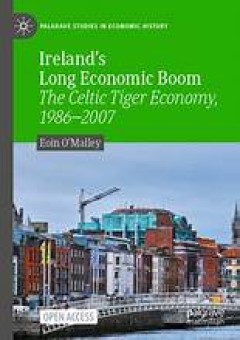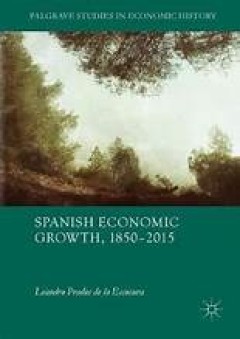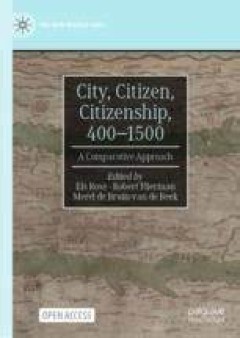Filter by

Ireland's Long Economic Boom
This Open Access book examines the long economic boom experienced in Ireland between the late 1980s and 2007, analysing why this boom occurred.
- Edition
- 1
- ISBN/ISSN
- 978-3-031-53070-8
- Collation
- -
- Series Title
- -
- Call Number
- XVI, 264

Spanish Economic Growth, 1850–2015
This book is open access under a CC BY 4.0 license. This text offers a comprehensive and nuanced view of the economic development of Spain since 1850. It provides a new set of historical GDP estimates for Spain from the demand and supply sides, and presents a reconstruction of production and expenditure series for the century prior to the introduction of modern national accounts. The author …
- Edition
- 1
- ISBN/ISSN
- 978-3-319-58042-5
- Collation
- -
- Series Title
- Palgrave Studies in Economic History
- Call Number
- XXIV, 383

City, Citizen, Citizenship, 400–1500
This open access book explores how medieval societies conversed about the city and citizen in texts, visual imagery and material culture. It adopts a long-term, interdisciplinary, and cross-cultural perspective, bringing together contributions on the early, high, and later Middle Ages, covering both the medieval East and West, and representing a wide variety of disciplinary angles and sources. …
- Edition
- 1
- ISBN/ISSN
- 978-3-031-48561-9
- Collation
- -
- Series Title
- The New Middle Ages
- Call Number
- XVII, 500

Living with Disfigurement in Early Medieval Europe
This book is open access under a CC-BY 4.0 license. This book examines social and medical responses to the disfigured face in early medieval Europe, arguing that the study of head and facial injuries can offer a new contribution to the history of early medieval medicine and culture, as well as exploring the language of violence and social interactions. Despite the prevalence of warfare and …
- Edition
- 1
- ISBN/ISSN
- 978-1-137-54439-1
- Collation
- -
- Series Title
- The New Middle Ages
- Call Number
- X, 282

Fungal Disease in Britain and the United States 1850-2000
This book is open access under a CC BY license. The narrative of 20th-century medicine is the conquering of acute infectious diseases and the rise in chronic, degenerative diseases. The history of fungal infections does not fit this picture. This book charts the path of fungal infections from the mid 19th century to the dawn of the 21st century.
- Edition
- 1
- ISBN/ISSN
- 978-1-137-37702-9
- Collation
- -
- Series Title
- Science, Technology and Medicine in Modern History
- Call Number
- XIII, 225

The Ndebele, Frank Oates, and Knowledge Production in the 1870s
This open access book addresses a question fundamental to the histories of empire and Africa: at the point of the colonial encounter, how was knowledge made? How did different communities, with little or no prior contact, construct meaning about one another? Amidst huge changes in the politics and economics of a continent, on the cusp of almost complete colonization at the hands of European pow…
- Edition
- 1
- ISBN/ISSN
- 978-3-031-75964-2
- Collation
- -
- Series Title
- Cambridge Imperial and Post-Colonial Studies
- Call Number
- IX, 125

East Central Europe Between the Colonial and the Postcolonial in the Twentiet…
This open access book explores the ambiguity of East Central Europe during the twentieth century, examining local contexts through a comparative and transnational reworking of theoretical models in postcolonial studies. Since the early modern period, East Central Europe has arguably been an object of imperialism. However, at the same time East Central European states have been seen to be coloni…
- Edition
- 1
- ISBN/ISSN
- 978-3-031-17487-2
- Collation
- -
- Series Title
- Cambridge Imperial and Post-Colonial Studies
- Call Number
- XII, 265

Medical Missionaries and Colonial Knowledge in West Africa and Europe, 1885-1914
This open access book offers an entangled history of hygiene by showing how knowledge of purity, health and cleanliness was shaped by evangelical medical missionaries and their encounters with people in West Africa. By tracing the interactions and negotiations of six Basel Mission doctors, who practised on the Gold Coast and in Cameroon from 1885 to 1914, the author demonstrates how notions of …
- Edition
- 1
- ISBN/ISSN
- 978-3-031-27130-4
- Collation
- -
- Series Title
- Cambridge Imperial and Post-Colonial Studies
- Call Number
- XVIII, 454

Shaping Natural History and Settler Society
This book explores the life and work of Mary Elizabeth Barber, a British-born settler scientist who lived in the Cape during the nineteenth century. It provides a lens into a range of subjects within the history of knowledge and science, gender and social history, postcolonial, critical heritage and archival studies. The book examines the international importance of the life and works of a marg…
- Edition
- 1
- ISBN/ISSN
- 978-3-030-22639-8
- Collation
- -
- Series Title
- Cambridge Imperial and Post-Colonial Studies
- Call Number
- XXIV, 360

Modelling our Changing World
This open access book focuses on the concepts, tools and techniques needed to successfully model ever-changing time-series data. It emphasizes the need for general models to account for the complexities of the modern world and how these can be applied to a range of issues facing Earth, from modelling volcanic eruptions, carbon dioxide emissions and global temperatures, to modelling unemployment…
- Edition
- 1
- ISBN/ISSN
- 978-3-030-21432-6
- Collation
- -
- Series Title
- Palgrave Texts in Econometrics
- Call Number
- XIX, 128
 Computer Science, Information & General Works
Computer Science, Information & General Works  Philosophy & Psychology
Philosophy & Psychology  Religion
Religion  Social Sciences
Social Sciences  Language
Language  Pure Science
Pure Science  Applied Sciences
Applied Sciences  Art & Recreation
Art & Recreation  Literature
Literature  History & Geography
History & Geography